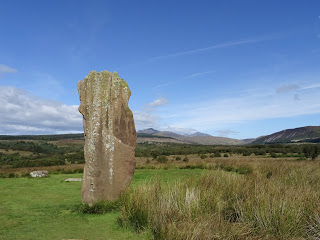On Machrie Moor there stand six stone
circles, so I headed off there for a wander around an ancient landscape of
standing stones and distant hills.
From the car park I headed off along a gentle
and winding path that led me through fields of sheep, and then out into a land
of mystical magic. There is almost
something unreal about the moor, it is sort of Hollywood film set in the way it
looks. All it really needed to finish it
off would be some pixies and wizards wandering around, maybe a group or two of
druids...or a few hobbits. But this is
no film set, it is real. It is a
landscape of Neolithic ritual and also of everyday domestic activity with the
remains of hut circles and ancient farming activity having been discovered
there.
Just by the derelict buildings of Moss
Farm stands a circle of stones known as Fingal’s Cauldron Seat. This consists of a ring of inner stones and a
ring of outer stones. Local legend has
it that on one of his many journeys through Arran, the warrior giant Fin McCool
cooked his tea in a huge cauldron supported by the inner ring of stones and
tethered his dog to one of the outer stones.
Down from the farm buildings and in a
more peaty and mossy area sit, or should that be stand, a whole load more stone
circles. Some of these are made from
granite boulders, while others are tall slabs of sandstone. The stones circles are thought to date from
around 4,500 years ago and were places of religious activity for many years, being
used as burial sites long after they had been built.
The stone circles on Machrie Moor have
long held a fascination for natives and visitors to Arran alike, with Patrick
Murray writing in 1883 that – ‘...in the whole Island, I know of no more
interesting sight, or one better worth visiting, than the stone circles of the
Machrie Moor. As you approach them, the tall upright forms of the standing
stones rise up before you, silent and solemn, from the solitary heath. As we look on them the mind wanders backward
over the ages with a strong desire to know something of the people who must
have toiled and laboured at their erection. Who were they.? In what
age did they live? What was
the nature of their religious belief? That the circles have been used at some
time as places of burial has been ascertained; but was that their original or
their only use? Have they not also been used as places of worship? For answer
to all this we can only conjecture, but I think we shall not greatly err if we
recognise in them the silent tribute of a people long since passed away to that
mysterious Power which governs the universe and overlooks the actions of man.’
After a wander around the marshy ground absorbing
the atmosphere of the place, and absorbing a lot of water into my rather
inadequate footwear, I left the Skulferatu that had accompanied me on my trip, in
a hollow, high up in one of the stones.
The coordinates for the location of the
Skulferatu are –
Latitude 55.540656
Longitude -5.312024
what3words: vote.weekday.arranger
I used the following sources for
information on Machrie Moor –
Information boards at
the site
The Book of Arran
Edited by J. A. Balfour
1910
Natives of Arran in
Glasgow
Ayrshire Weekly News and
Galloway Press - Saturday 10 February 1883


































.JPG)
.JPG)
.JPG)
.JPG)
.JPG)
.JPG)
.JPG)
.JPG)
.JPG)
.jpg)


